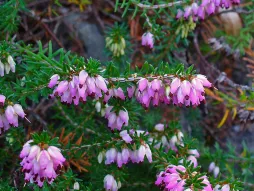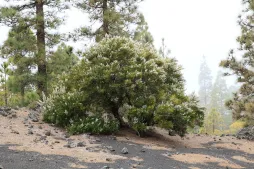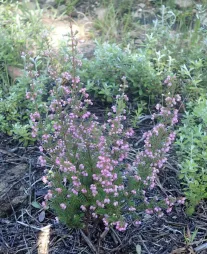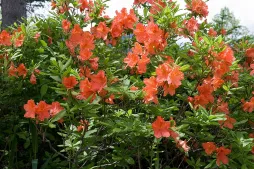Erica darleyensis, the winter heather
Winter heather, in Latin Erica darleyensis, is a hybrid variety obtained by crossing alpine Heather (Erica carnea) and Erica erigena. The plant is prized for its flowering, which starts in winter and continues into spring.
How to recognize winter heather, Erica × darleyensis?
Erica darleyensis grows to a height of 60 centimetres, with an equal spread. This perennial has a dense, bushy habit.
The slender, branched stems stand almost perpendicular to the ground. They are covered with green leaves. Linear and obtuse, they are no more than a centimetre long and three millimetres wide, reminiscent of pine needles.
Winter heather blooms as early as January. The flowers, grouped in clusters, resemble bells or bells. Their four petals are tightly packed, revealing variegated stamens. Flower color depends on the cultivar. Flowers can be pink, as with Erica "Kramer's Rote" and Erica "Eva Gold", or white, as with the varieties "White perfection" and "White Spring Surprise".
Erica darleyensis is not known to be toxic. However, the plant is not edible either. Ingesting it can cause digestive problems in sensitive people and animals.
Our maintenance tips
Winter heather are easy-care plants. Once well established, they require almost no care.
Watering
Your Winter heather likes humidity. The plant appreciates frequent and generous watering. But its roots may rot if you overwater. To get the dosage right, leave the soil to dry out partially between two waterings (by about a centimetre). The substrate should always remain slightly moist.
After each watering, remove any stagnant water from the saucer or planter to avoid drowning the roots.
Repotting
Soak the root ball of your Winter heather to rehydrate it. Shake the plant to remove excess water.
Get a pierced terracotta pot. You can make a bed of clay balls at the bottom to improve drainage. Mix at least 25% heather soil with ordinary potting compost. Pour on a layer of substrate and plant your Winter heather.
Water generously to remove air bubbles and encourage rooting.
Fertilization
To promote the growth of your Erica × darleyensis, apply fertilizer in spring and summer.
Apply a fertilizer for heathland plants every two weeks. Follow the manufacturer's instructions to avoid damaging the foliage.
Prune
You are not obliged to prune your Erica × darleyensis. You can, however, shorten branches with a clean, sharp tool to maintain a compact, rounded habit. Don't cut into old wood: the plant won't recover.
Also remove any spent flowers.
Plantation
When the risk of frost has passed, it's time to plant.
Soak the root ball of your Erica × darleyensis plant. This will help the plant adapt better to its new environment.
Dig a planting hole twice as deep and wider than the root ball to prepare the soil. Winter heather likes acidic, well-draining soil. If this is not the case in your garden, mix 2/3 heather soil with 1/3 ordinary potting soil. You can add sand to improve drainage.
Lay down a layer of substrate and plant your Erica × darleyensis. The root ball should be level with the soil. Fill in the planting hole and water generously.
You can also mulch the base with organic matter to keep the soil fresh.
Cutting
Cutting is carried out during the strong growth phase, generally in spring and early summer.
Locate a healthy, flowerless stem. It should be semi-woody, but still flexible.
Cut a ten- to fifteen-centimetre section just below a node. Use clean, sharp secateurs to facilitate healing.
Remove the lower leaves and keep only the upper pair.
Plant your graft in a pierced pot lined witha rich, light substrate, such as potting soil with sand.
Install the cutting in a mini greenhouse. If you don't have one, you can cover it with a translucent bottle. Remember to aerate regularly and mist the soil if it dries out.
Disease / Threat
Information
| Family | Ericaceae - Ericaceae |
| Type | Erica - Erica |
| Species | Winter heather - Erica × darleyensis |
| Lifecycle | Perennial |
| Foliage | Evergreen |
| Exposure | |
| Substrat | |
| Planting methods |
Open ground In pots In tubs Planter |
| Category | |
| Tags |
Beginner Flowery Rustic |
| Origins |
Southern Europe Western Europe |
| Hardiness (USDA) | 6b |
| Leaf color |
|
| Flower colors |
|
Discover plants from the same family





















